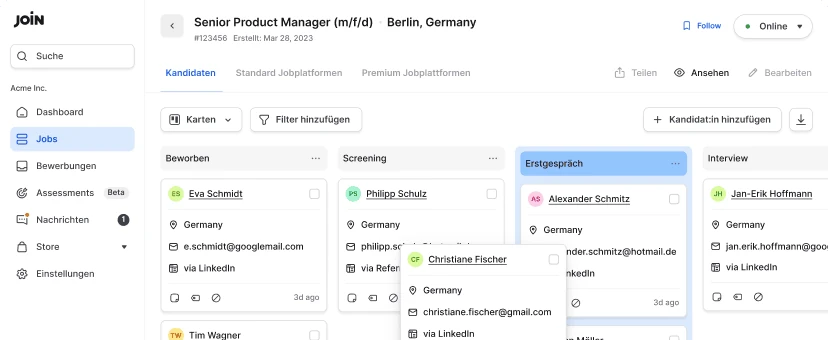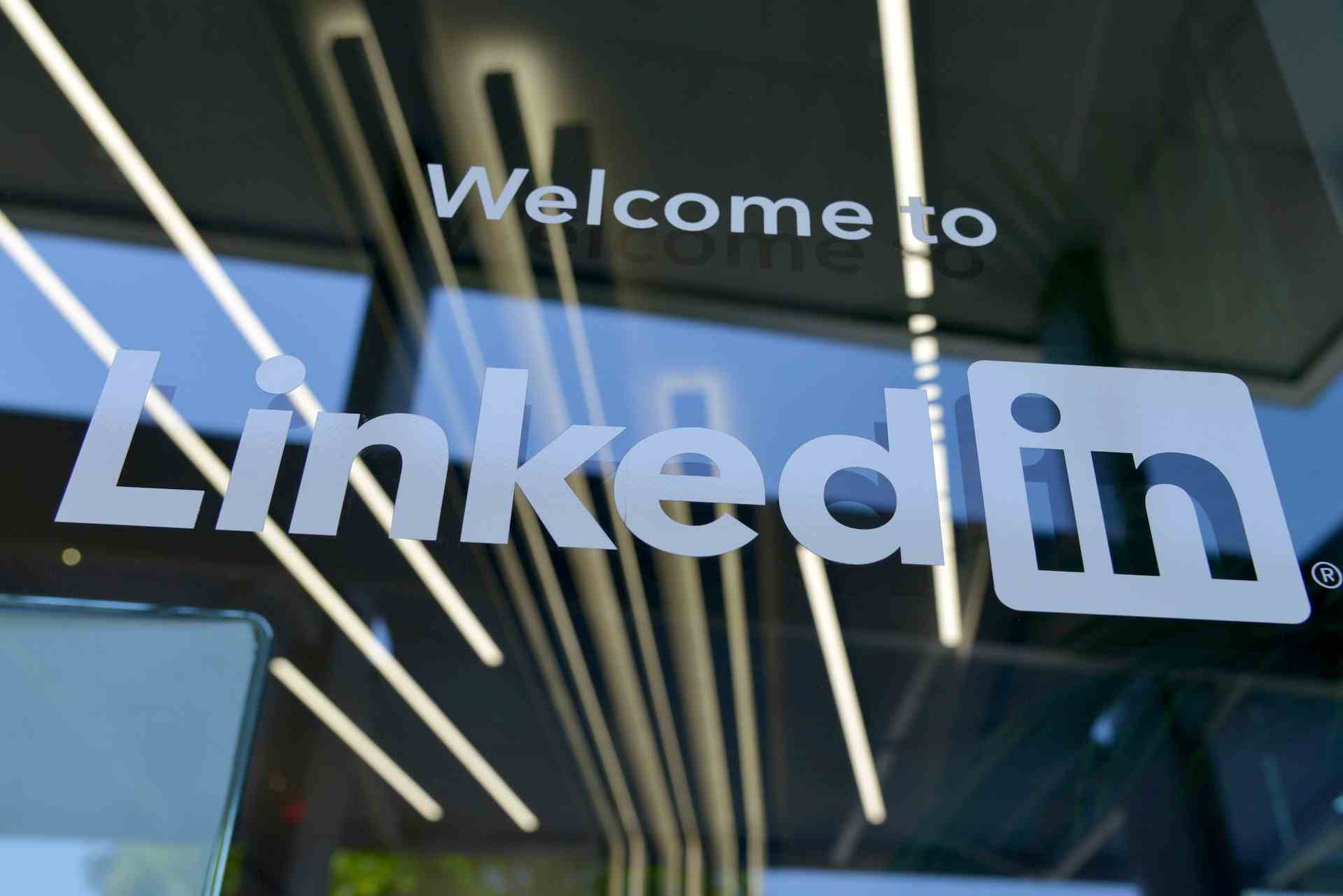How to create an effective recruitment communication strategy
An efficient recruitment communication strategy is an essential part of an optimised hiring process. By perfecting your candidate communication, you can increase your chances of quickly filling open positions. And this is especially crucial right now, as companies struggle to attract and retain top talent.
Table of contents
The COVID-19 pandemic, the Great Resignation, and continuing labour shortages across most industries have left companies scrambling to find qualified candidates to fill their job openings. And even if you’re lucky enough to receive a stellar application, there’s a high risk that the candidate will drop out of your hiring funnel before you’ve made them a job offer.
To prevent this from happening, you need to optimise your hiring process and create a smooth candidate experience from start to finish. A crucial part of this is an effective and efficient recruitment communication strategy.
Below, you’ll find out why communication is key in the hiring process and what steps you can take to improve the way you communicate with candidates. Follow these tips to increase your chances of hiring that top talent.
- What is a recruitment communication strategy
- The importance of a streamlined recruitment communication strategy
- Why do companies fail to create an effective candidate communication strategy during their hiring process
- 7 steps to improve your recruitment communication strategy
What is a recruitment communication strategy
A recruitment communication strategy maps out how you communicate with candidates throughout your recruitment process.
Without a clear strategy in place, you risk your candidate communication being unstructured, unorganised, and even unprofessional. Your communication may seem sloppy, and your responses may be slow. A recruiting communication strategy helps solve this by structuring how you communicate with a candidate at each touchpoint during the process.
Moreover, by effectively using communication templates and automated messages (more on this below), the communication strategy can significantly speed up your hiring process.
The importance of a streamlined recruitment communication strategy
An optimised recruiting communication strategy can make or break your talent attraction efforts. Let’s quickly look at the top five reasons why effective communication is so essential in recruitment.
1. Decreases time to hire and time to fill
Research found that as much as 60% of candidates have dropped out of an application process before it ended because it took too long.
Optimising (and partly automating) your candidate communication can help significantly speed up your hiring process, thus improving your company’s time to fill and time to hire rates.
2. Increases offer acceptance rate
The quicker a candidate moves through the hiring pipeline, the higher the chance that you can send the job offer before they’ve lost interest.
And that means chances are you can expect a higher offer acceptance rate as well. This also reduces the cost per hire as the position is filled more quickly, and the chance of a potential hire dropping out during the process—and you having to restart from scratch—is reduced.
3. Better candidate experience
Faster and more structured communication will also increase the overall candidate experience. Too often, applicants are left uncertain about the timeline of your hiring process and what to expect.
Moreover, a communication strategy that’s not thought through is prone to produce inconsistent, incoherent messaging that leaves the candidate wondering how professional your organisation really is. After all, if you can’t even produce a clear structure or organised messaging during the recruitment process, it raises the question of what lies ahead of them if they join your company.
An optimised, personalised, and above all human communication strategy sends a positive and professional message about your company as a whole. This all leads to a more positive overall candidate experience.
4. Increase candidate satisfaction
Candidate experience goes hand in hand with candidate satisfaction. The better and more professional you communicate with your candidate, the more satisfied the applicant will be with the process they’ve followed.
5. Improves employer branding
Lastly, all of the above adds to building your company brand’s reputation. Leaving your candidate with a more positive experience, regardless of whether they end up being hired or not, will help improve your overall employer branding.
Even if the candidate is rejected, they will still look back on a positive experience throughout the process, making them more likely to recommend their connections to apply to positions at your organisation.
Why do companies fail to create an effective candidate communication strategy during their hiring process
So, what are some of the common pitfalls you have to look out for? And why do so many companies struggle to communicate effectively with candidates, failing to promote the five points mentioned above?
The main reasons are:
- Lack of time
- Lack of resources
- Lack of automation
- Lack of strategy
These reasons tend to coincide and reinforce each other. For example, without an optimised strategy, you might waste time and resources on steps in the process that could have easily been automated.
This may sound like an unescapable, self-perpetuating loop of lacking and lagging behind. But by following a few simple steps, and automating your recruitment communication process where possible, it doesn’t have to be a difficult or time-consuming endeavour.
7 steps to improve your recruitment communication strategy
Below, we’ll walk you through some of the key steps to improve your candidate communication. This way, you can provide consistent and efficient communication and give your prospective team members a smooth candidate journey.
1. Candidate communication starts with your employer branding
Although a recruitment communication strategy is a separate process, it should generally be in line with the wider way in which you present your business to the outside world. For example, if your branding (both visual and verbal) is fun and informal, you probably want your candidate communication to match.
If, instead, you communicated with a candidate in an extremely formal and perhaps even blunt way, their interaction with you might become disjointed from the brand they applied to work with. This can leave the candidate in doubt about the true identity of your business.
Note that although you generally want candidate communication to fit your brand tone of voice, this doesn’t always have to be the case. For example, a legal B2B company’s brand tone and voice could be quite formal, but if the team is made up of international young professionals the candidate communication could be more informal.
So before creating a hiring communication strategy, consider your branding and how you normally communicate externally. In most business cases, you want to ensure that your candidate communication is aligned with your brand guidelines, in particular the tone and voice on your website (and other channels like social media—especially LinkedIn—or email).
2. Personalise and humanise the process
Regardless of your tone and voice, when communicating with candidates, it’s important to always try to stay human and personal in your correspondence throughout the process.
For example, including the candidate’s name and adding personal information will go a long way in showing them they’re a person and not just another CV.
Of course, you probably won’t have time to write a completely new and personalised message from scratch every time. So using templates and automating some messages is certainly useful, if not essential.
But even then, try to ensure these messages, too, are given a personalised touch (more on this at point 5).
3. Identify common points of communication
Now you know how you want to say it, it’s time to identify where you will say it. At this stage, try to map out all the common, standard touchpoints in the hiring funnel at which you communicate with a candidate.
By outlining all of these instances, you get a clear picture of how your candidate moves through your funnel, making it easier to determine what to message and when. It further helps avoid duplicate messaging and oversharing of information. Again, speed is everything, and candidates can quickly get impatient. Asking for the same information twice or repeatedly communicating the same thing can make a candidate drop out of the process.
Equally, you might notice that you could actually do with sending more messages or sharing more information at additional touchpoints. For example, did you know that 70% of candidates don’t even receive a confirmation email after completing a job application? So adding this communication to your process already sets you apart from most other companies!
Here is an example list of potential touchpoints where you might message a candidate:
Before the candidate applies:
- Your career page
- Your job advertisement about the open position
- The application form/questionnaire (if applicable)
After the candidate applies:
- Confirmation of received job application
- Rejection of job application
- Invitation for screening interview
- Invitation for first interview
- Invitation for second interview
- Invitation for third interview (optional, depending on position)
- Sending an assignment
- The assignment itself
- Rejection after an interview (don’t forget to provide feedback after rejection)
- Sending a job offer
- Negotiating the contract
- Asking for feedback and/or to fill out a survey
Note that it’s advisable to communicate the estimated length and the steps of your recruitment process early on in the process, either directly in the job ad or in the application confirmation email.
4. Create a template library
Time to start writing the actual messages! Since every business and hiring process is different, what these messages look like and what information is shared will be unique to your company. However, there are a few general guidelines and pointers to bear in mind when drafting your communications.
At each stage, try to clearly communicate:
- The status of their application
- Their progress in the hiring process
- Any action required on their side
- The next step in the process
- That you are available for questions or feedback
- How they can best contact you
Regardless of the stage you’re writing the message for, always keep step one and two of this recruitment communication strategy described above in mind. These messages are often your first points of contact with your candidate. So perfecting these is crucial to leaving a great first impression!
5. Automate for speed while maintaining humanity
You want your candidate communication to be quick and powerful. That’s why your strategy will often revolve around finding the right balance between using templates and automation while still maintaining a personal touch.
Luckily, you can combine the two without compromising on speed or personality. When using an applicant tracking system like JOIN, you can create pre-written, personalised, automated messages that help you message candidates quickly and efficiently. Using such automation options ensures a fast process with a consistent candidate experience throughout. Win-win!
6. Be responsive and quick
A significant part of the candidate communication can’t be automated, nor can you fully prepare for it. For example, a candidate might come up with a specific question they have about an assignment you sent them.
Although you can’t prepare for these types of messages, you can ensure that you always answer them as quickly (and friendly) as possible. Again, this is where using a recruitment software can really come in handy!
With JOIN, you can easily communicate with candidates directly inside the tool. Regardless of which job board the candidate applied through, you receive all their messages inside the same single inbox.

7. Keep optimising your process
Keep in mind that you probably won’t create the perfect communication workflow in one go. And different roles and candidates will require different messaging. That’s why it’s important to stay agile in your approach. Adapt your communication strategy to specific hiring needs, and keep trying to improve the candidate experience.
An important way to achieve this is to ask for feedback from your candidates at the end of the process. You can do this either inside one of your messages to the candidate or through a separate feedback form or survey.
Candidate communication is just one part
The hiring communication strategy is an essential part of your wider recruitment process. It can help speed up the entire process, improving your chances of sealing the deal with a candidate before the competition beats you to it.
But efficient candidate communication alone is not enough to help you easily hire top talent. From an effective shortlisting process to the questions you ask during the interview.
Frans Lelivelt
Frans is JOIN's multilingual Senior Content Manager. His main topic of interest in the recruitment space is DEI and how companies can reduce their (unconscious) biases to make the world of work a fairer, kinder place for everyone. Outside of work, he tries to do the same for animals, spending much of his spare time in the kitchen preparing plant-based feasts.


